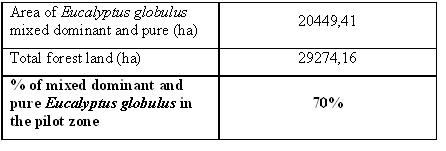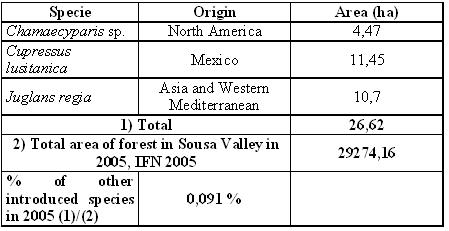Percentage of the total forest covered: 100 %
Costs
TOTAL COST: 27 €
The total cost includes :
1- Data analysis: 27 €
Results
Area of Eucalyptus globulus in Sousa Valley in 2005
Source: NFI, 2005
Other species introduced in Sousa Valley in the last 12 years with public co-financing
Source: AFVS
Remarks
The main specie introduced in Sousa Valley is Eucalyptus globulus which has its origins in Tasmania. The plantations of this specie took off in Portugal in the 1960s in order to supply wood for the pulp mills recently installed in the country. This specie has been replacing part of the pine forest damaged by forest fires. In the take off of this specie, the Forest Services played an important role by distributing plants free of charge to the forest owners. From 1981 to 1998 a programme financed by the World Bank provided credit to the public pulp and paper companies and to the Forest Services to carry on afforestation with Eucalyptus globulus. Some incentives for its plantation existed after this programme but they were drastically reduced in the end of the 1980s. So the more recent growth in the area of Eucalyptus globulus is almost totally funded by pulp and paper companies and private forest owners. The growth in eucalyptus stands has been taking over some of the burnt pine forests and some agricultural lands which are abandoned or which were actively farmed before but where this fast growing species are becoming economically more attractive than agricultural uses. In 2005, pure stands of this introduced specie occupied about 58,4 % of the total forest area of Sousa Valley.
Pinus pinaster may have been introduced by men’s hands, but long time ago, because there are traces of it since the Neolithic period. This specie expanded since the XVI century by plantation, by natural and artificial dissemination and by natural regeneration. For some time, the Forest Services distributed seeds to the local populations who spread them in the fields that were abandoning from agriculture. In other cases, the dissemination of pine forests in abandoned farmland happened simply by natural dissemination.
Lately, the co-funded EU afforestation programmes has been promoting the introduction of other species. Some examples are the Chamaecyparis sp., Cupressus lusitanica or Juglans regia. The area in the table above only covers the one planted by forest owners that are members of the local FOA. They have a very small representation in the total forest of Sousa Valley.
Problems and improvements
This indicator is feasible at the regional level and can be updated every time that a new NFI is accomplished. More specified data on introduced tree species can be obtained close to the local FOA. However, that information only covers the forest belonging to its members and not to the remaining forest. In the future, the forest area covered by ZIFs (Zones of Forest Intervention) will be under forest management plans and the information on introduced tree species will be probably recorded by the local FOA.
Conclusions
Eucalyptus globulus is the main specie introduced in Sousa Valley and also the main forest specie there. The introduction of other species is been undertaken with the help of EU co-funded forest programmes but the area stills insignificant.
The diversification of forest species may help to diminish the risk of fire propagation as well as the attacks of pest and diseases. However, this diversification is difficult to put in practise since Eucalyptus globulus is very important in terms of local economy and the forest owners prefer to have revenues in the short run.
In Sousa Valley, the continuous stands of Eucalyptus have been more and more damaged by fire which is negative in terms of its sustainability.
The local FOA has been providing details to the forest owners about the alternatives to the Eucalyptus globulus and the advantages of planting broadleaves of valuable timber in the long run.
Besides the introduced species referred above, Sousa Valley offers good conditions to the development of the following species: Pinus radiata, Salix alba, Platanus hybrida and Pseudotsuga menziesii.
So far, the plantations with other broadleaves but Eucalyptus and other slow growing species occur mainly with the help of public financing. Collective forest organisation is a possible solution to congregate at the same time economic and conservation management options in Sousa Valley.
The diversification of forest species can be important in terms of conservation, animal biodiversity and reduction of the risk of forest fires.
Indicator not considered by the Criterion 4 of the Portuguese Norm 4406 2003.



Initiative Communaitaire FEDER
INTERREG IIIB Espace Atlantique

